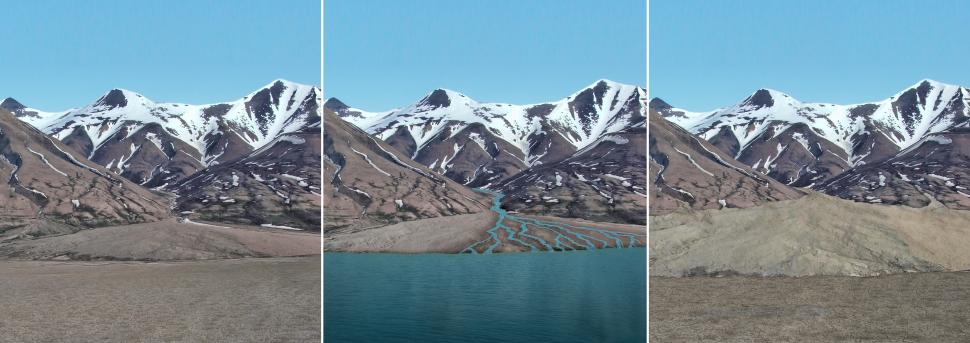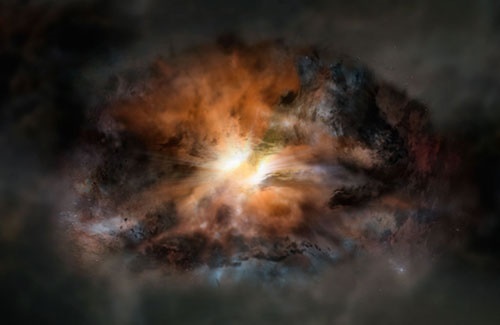A brief introduction to the brain
Neuroscience is a vast subject, so we have tried to present the basic information you may need in order to understand the neuroscience behind mindfulness. Much of the content of this page has been extracted or adapted from Dr Shanida Nataraja's book "The Blissful Brain: Neuroscience and proof of the power of meditation", which is available in the Mindfulnet Amazon shop located on the resources page. All extracts and illustrations have been reproduced with the permission of the publisher & author

The human brain is a reddish grey mass, with the consistency of firm jelly, which weighs on average the same as three bags of sugar and houses 100 billion individual brain cells calledneurones. Each neurone has a cell body which houses its processor, the nucleus. Branching from the bodies are numerous finger likedendrites which branch and re-branch, fanning out to extensive, tree like structures that intertwine with dendritic trees of other neurones. Each neurone makes up to 1000 different connections with its neighbours and different areas of the brain. This extensive connectivity allows electrical signals, and thus information to travel from one brain processing centre to another in a matter of milliseconds.
The human brain is organised in a hierarchical manner: the oldest parts controlling the more primitive, instinctual behavioural reflexes; the newest parts controlling the more sophisticated cognitive, sensory and motor functions. The human brain is made up of three main blocks: the forebrain, the midbrain and the hindbrain.
The oldest part of the human brain, the hindbrain, evolved more than 500 million years ago. It closely resembles the brain of a modern reptile, so is sometimes called "the mammalian brain". It is responsible for automatic physiological reflexes that control breathing, heart rate and digestion, and coordinate movement and sense perception.
The midbrain contains neurones responsible for temperature control and the fine tuning of movement. It relays sensory information from the bodies sensory organs to the forebrain. It also plays an important part of the limbic system, a group of brain structures associated with the expression of emotion.
The most evolved part is the forebrain which is composed of cerebral hemispheres, and is what we most commonly think of as the brain, and the hypothalamus and thalamus. In the last 100,000 years, the weight of the human brain has tripled, and most of this growth has been in the cerebral hemispheres. The neurones of the forebrain control cognitive, sensory and motor function, as well as regulating reproductive functions, eating, sleeping and the display of emotion
Right Brain and Left Brain
Although you may often hear people referring to "left brain thinking" or "right brain thinking" there are extensive connections between the two brain hemispheres and information is processed by using both hemispheres of the brain. Imaging studies have shown that most cognitive tasks such as problem solving or strategic planning or strategic planning activates neurones in more than one brain region simultaneously, or at least in close succession.
For example is you are inspecting a new, never seen before object, the left hemisphere examines the object logically to see how it has been made, what it is made from, any distinguishing marks, and attempts based on the information gathered to guess what the object might be, and may try to logically catagorise it. This gives a partial description. The right hemisphere looks at the object more holistically, notes any functions in its design, or clues about what it may have been used for, how it feels, or any emotions it may evoke. The right hemisphere puts this into the context of what it already 'knows' about the world and then offers creative suggestions for its function. By working together as a team, sharing logical and creative information, the two hemispheres can generate a more complete description.

For
simplicity of explanation, the left hemisphere is associated with analytical, rational and logical processing, where as the right hemisphere is associated with abstract thought, non verbal awareness, visual & spatial perception and the expression and modulation of emotions.
In the western world, most individuals navigate through their everyday life in a fashion dominated by left brain thinking. Missing out on right brain activity results in too much thinking going on: too much frantic doing, not enough time being.
Right brain, left brain and mindfulness
According to neuroscientist, Dr Shanida Nataraja, westerners use the left hemisphere of their brain too much.
For simplicity of explanation, the left hemisphere is associated with analytical, rational and logical processing, where as the right hemisphere is associated with abstract thought, non verbal awareness, visual & spatial perception and the expression and modulation of emotions. In the western world, most individuals navigate through their everyday life in a fashion dominated by left brain thinking. Missing out on right brain activity results in too much thinking going on: too much frantic doing, not enough time being.
Practicing mindfulness can bring about calmness, stilling the brain chatter, and help us shift towards right brain mode.
By engaging our right brain we activate the parasympathetic nervous system (as opposed to the adrenaline releasing sympathetic system). More parasympathetic activity means less stress and therefore better health.
According to Neuroscientist Dr Shanida Nataraja's studies, those new to meditation practices such as mindfulness often put pressure on themselves to be successful and "get there" quickly - a left brain "are we there yet?" approach - and consequently take longer to benefit. Shinda suggests that the key is to be kind to yourself, acknowledging thought and letting go. This activates certain pathways in the brain which reduce left brain activity
Mindfulness is classed as a passive form of meditation. The following illustrations and description of the overall chain of brain processes during mindfulness meditation is an extract from Dr Shanida Nataraja's book "The Blissful Brain: Neuroscience and proof of the power of meditation", which is available in the Mindfulnet Amazon shop located on the resources page. The extracts and illustrations have been reproduced with the permission of the publisher & author.

The meditator begins with the intention to clear his mind of thoughts. This intention is reflected in an increase in activity in the attention association area. As he slowly quietens his mind, there are further increases in activity in the attention association area. At the same time, activity in the frontal cortex regions surrounding the attention association area decreases. This is the result of focused attention and reflects a filtering out of all information that is not deemed important. Attention is drawn to the present-now experience, which triggers a shift to right-brained activity, as attention is predominantly a right-brained function. This shift from 'intellectualised' left-brain thinking is a further explanation of why the experience cannot be described or analysed: the right brain does not have the ability to categorise and analyse the experience; it intuitively 'feels' it.
At the same time, the meditator also becomes less aware of sensory information stemming from his external environment, and therefore less aware of his orientation in space and time. This dissolving of the self / non-self boundary is reflected in a decrease of activity in the right parietal lobe. Not only does it have an impact on activity in the right orientation association area (leading to a loss of sense of space and/or time), but it also has an impact on activity in the right verbal-conceptual area, leading to an inability to convey the experience efficiently through language. (see step 1 in illustration above)
This chain of events is thought to result in the activation of two important structures in the limbic system. There are extensive connections between the parietal lobe's orientation association area and the hippocampus (see step 2 on illustration above), which in turn stimulates the amygdala. These two structures are responsible for assigning emotional significance to our experiences. The activation of the hippocampus conveys emotional significance of the experience and imprints the emotionally charged experience and imprints in our long term memory.
When practicing mindfulness the activation of the amygdala confers emotional significance to the lack of sensory information. Through these actions on the hypothalamus, the amygdala modifies the activity of the autonomic nervous system (see step 3 in illustration above).
First a blissful, peaceful state arises from the maximal activation of the parasympathetic (relaxation) nervous system, and then, as the different neural, hormonal and other triggers swing in, there is a maximal activation of the sympathetic (arousal) nervous system, producing a mentally clear and alert state. Physiological effects, such as changes to breathing rate, heart rate or blood pressure are the result of the amygdala's effect on midbrain structures that control these functions (see step 4 in illustration above).
Both of the left and right orientation and verbal-conceptual association areas are therefore switched off. A lack of activity in the right orientation association area gives rise to a sense of unity and wholeness, where as lack of activity in the left orientation association area results in the dissolving of the self/non-self boundary
Cognition Improved By Mindfulness Meditation
Some of us need regular amounts of coffee or other chemical enhancers to make us cognitively sharper. A newly published study suggests that mindfulness would prepare us just as well.
While past research using neuroimaging technology has shown that meditation techniques can promote significant changes in brain areas associated with concentration, it has always been assumed that extensive training was required to achieve this effect.
Surprisingly, the benefits may be achievable even without all the work. Psychologists studying the effects of a meditation technique known as "mindfulness " found that mindfulness-trained participants showed a significant improvement in their critical cognitive skills (and performed significantly higher in cognitive tests than a control group) after only four days of training for only 20 minutes each day.







